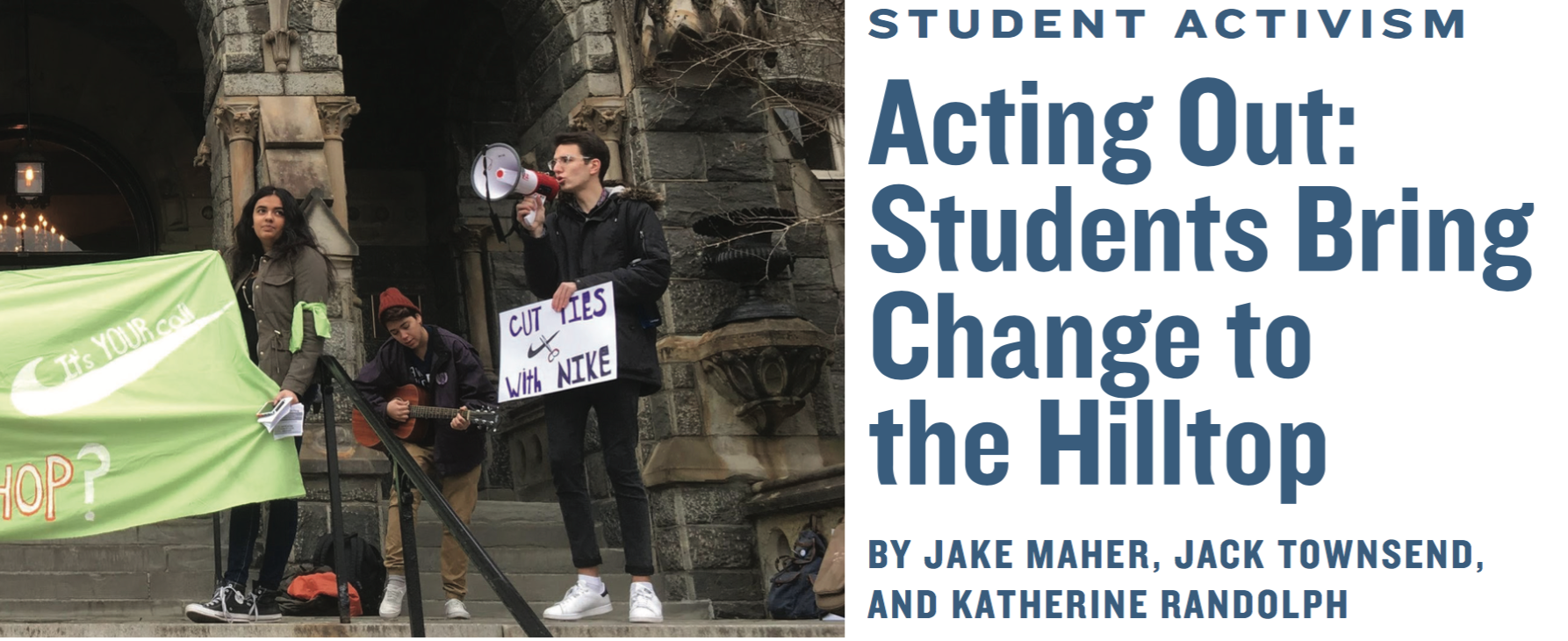Georgetown’s front gates sit roughly four miles from the United States Capitol. Perhaps it is this proximity to policymakers, or the university’s Jesuit identity, that make Georgetown a haven for student activists. For our 50th anniversary, the Voice is looking back at some students’ more recent attempts to bring change to campus.
Student activism at Georgetown runs the gamut of political views. It is liberal and conservative, well organized and loosely arranged. Activists confront the university on campus concerns—issues like workers’ rights and sustainability—and those that reach a national level—like reproductive rights and immigration.
Activism at Georgetown takes multiple forms but retains a common goal: making change, whether of the university, the nation, or the world.
***
As undocumented immigration to the United States has become a hot-button national issue, both university students and administrators have made their voices heard.
In 2016, UndocuHoyas, a group supporting undocumented Georgetown students, demanded that the university rescind its invitation to former Secretary of Homeland Security Jeh Johnson to speak at the School of Foreign Service’s commencement. The group argued that Johnson, as the leader of the government department responsible for deporting undocumented immigrants, represented policies and efforts to separate students’ families.
While the university ultimately did not rescind Johnson’s invitation, UndocuHoyas’ opposition fueled an ongoing conversation about undocumented students’ on the Hilltop.
Arisaid Gonzalez (COL ’21), the current president of Hoyas for Immigrant Rights, said that her group teaches students about issues that affect immigrants.
“Georgetown does a very good job of helping us out,” she said. “We have a director of undocumented [student] services. They provide need-blind financial aid. Anything with money and legal help, they have it.” However, she said the university was “a little bit faulty” in supporting undocumented students’ families. Though Georgetown protects undocumented students from deportation, the safety net does not apply to their loved ones outside of the Hilltop.
Much of Gonzalez’s activism is university-centric, but she has taken advantage of Georgetown’s position in D.C. as well. Gonzalez participated in a sit-in in the office of Senator Michael Bennet (D-Colo.) in 2017 and attended this year’s State of the Union address.
Scott Fleming, who served as Georgetown’s associate vice president for federal relations from 2001 to 2018, helped Georgetown activists collect and deliver postcards for members of Congress signed by students in support of undocumented Hoyas.
“That was, to me, the biggest thing we did,” Fleming said.
***
Conservative activism on campus often looks different from other activism, said Amelia Irvine (COL ’19), former president of both Georgetown Right to Life and pro-Catholic social values group Love Saxa. Instead of sit-ins and protests in Red Square, Irvine talked about “flag day,” an annual event run by Right to Life in which students plant small flags on Copley lawn to memorialize the average number of abortions performed in the U.S. every day.
“The best thing that I can do is represent my views in an articulate and clear way and to act with kindness in what I do,” Irvine said. And she does not always aim to persuade people either.
“Success is not necessarily changing minds, but it is starting the conversation and planting the seeds in other people so they at least understand how the other side sees things.” The university is generally supportive, at least of her work with Right to Life, according to Irvine.
But Love Saxa is another matter. The group, which promotes Catholic teaching on marriage and relationships, came under scrutiny from students in the fall of 2017 for rejecting the legitimacy of gay marriage. Two students asked the Student Activities Commission (SAC) to defund Love Saxa, which they said violated Georgetown’s policies against student groups that “foster hatred or intolerance” based on several characteristics, including sexual preference. In the following SAC hearings, Irvine and other members of Love Saxa fought to retain university funding, gaining national attention in the process.
SAC decided in favor of Love Saxa, so along with Right to Life, the group still occupies a small but enduring spot in conservative campus activism.
***
Like Gonzalez and Irvine, Celia Buckman (SFS ’21) advocates on campus for a broader issue. In Buckman’s case, it’s global. As president of GU Fossil Free (GUFF), Buckman and her group work toward getting Georgetown to sell off its investments in companies associated with fossil fuels from its endowment.
When GUFF started in 2012, the group held sit-ins and rushed the stage at a Gaston Hall event with a banner advertising the cause.
“As you can imagine, the administration didn’t really like that,” Buckman said. “But I think that it was the only method to reach them.”
Since then, the university has become more receptive to GUFF’s requests, Buckman said. The university’s board of directors formed the Committee on Investments and Social Responsibility (CISR) in 2017 to respond to requests like GUFF’s to divest from fossil fuels.
GUFF submitted a sweeping proposal calling on the university to completely divest from fossil fuels in 2014, but the university chose only to divest from thermal coal, an especially harmful kind of fossil fuel. The group submitted an updated proposal in January 2019, renewing its call for complete divestment.
Now that they have built stronger relationships with administrators, Buckman said, GUFF has more traction. “That’s really a culmination of so many years of working with them to have a working relationship of any kind,” she said.
Unlike many activist groups, however, GUFF is not designed to be a permanent campus fixture. Buckman said that the group has an endgame.
“GUFF is a campaign. We want to work ourselves out of a job,” she said.
***
While organizations like GUFF and Love Saxa are relatively new presences on campus; other activist groups have a more established history. H*yas for Choice (HFC), an unrecognized student group, has advocated for reproductive justice and abortion access since 1991. The group now distributes contraceptives and lobbies university officials to supply birth control on campus.
HFC president Angela Maske (NHS ’19) said the group’s style of activism has changed over the past decade. For example, HFC has moved away from the term “pro-choice” in favor of “reproductive justice.” To Maske, this means focusing less specifically on abortion and more generally on reproductive health.
“We really believe in a version of reproductive justice which means being able to decide if, when, and how you get pregnant, being able to have a healthy pregnancy and access to things like prenatal care, and being able to raise your children in a safe and healthy environment,” Maske said.
Earlier in the decade, however, HFC was known primarily for provocative direct action. In 2010, they partnered with United Feminists for the “Plan A: Hoyas for Reproductive Justice” campaign. They advocated for contraceptives on campus, rape kits at the Georgetown Medstar Hospital, and sex education for students. Some even chained themselves to the John Carroll statue, demanding to meet with university officials about reproductive health issues. Their protest was effective to a point. Although Vice President of Student Affairs Todd Olson agreed to meet with the students that evening, many of their demands were never met.
In September 2018, HFC began offering the emergency contraceptive Plan B to students on campus, funded by outside donations. In addition to tabling in Red Square and the Leavey Center and offering free condoms to students on campus, HFC has moved toward pushing for more accessible STI screenings and opposing on-campus pro-life events.
This includes protesting the annual Cardinal O’Connor Conference on Life, which Georgetown hosts in Gaston Hall. This year, Maske said that HFC flyered in university buildings in addition to protesting, a decision she credits to the group’s move from pure activism to organizing.
“Organizing is far more than a one-and-done event,” Maske said. “Those pieces do play a part in organizing, but I think organizing is a lot more strategic, and it also involves building relationships with others in order to learn from their experiences and help them find a place in the movement.”
***
Ayo Aruleba (COL ’17) remembers the protests, which he helped organized, that prompted the university to confront its legacy of owning and selling slaves. “It almost felt like a responsibility to do something about what was going on.”
The story of the 272 enslaved people sold by the university in 1838 to keep the university solvent, now known as the GU 272, received national attention in 2015 as archivists began identifying descendants of the slaves, many of whom live in the small town of Maringouin, Louisiana. In September 2015, university president John DeGioia convened the Working Group on Slavery, Memory, and Reconciliation to consider ways to address Georgetown’s past participation in slavery.
The working group’s progress coincided with student protests at Yale University and the University of Missouri in late 2015 against institutional racism. Aruleba and several other students organized a rally to stand in solidarity with students at those colleges, but realized that they needed to make a direct change at Georgetown as well.
“It was something me and my friends were reading on social media, were reading in the news, because our friends and family at different institutions and at Georgetown were facing these kinds of things, so it was very personal,” Aruleba said.
They decided to organize a sit-in outside DeGioia’s office to demand that the university change the titles of Mulledy and McSherry Hall, buildings named after Jesuits who oversaw the sale of the GU 272. On Nov. 13, 2015, around 35 students sat  outside DeGioia’s office from 9 a.m. until midnight.
outside DeGioia’s office from 9 a.m. until midnight.
“Black individuals have historically been an integral part of the foundation and advancement of Georgetown’s academic Institution with little to no recognition,” the group wrote in a statement. “We are imploring that the University recognize and acknowledge the role that Black people have had and continue to have on this campus.”
The day after the sit-in, DeGioia announced that the buildings would be temporarily renamed Freedom and Remembrance Halls.
Student activists started conversations that answered some questions about Georgetown’s responsibilities to descendants, but left others unanswered. Georgetown decided to permanently rename the buildings after Isaac Hawkins, the first person listed on the bill of sale, and Anne Marie Becraft, the founder of one of the first schools for black girls in Georgetown, and offered legacy admissions status to descendants. But the Isaac Hawkins Legacy Group, an association of Hawkins’ direct descendants, has been unsuccessfully calling for financial compensation for their ancestor’s work since early 2018.
In February 2019, GUSA approved an April referendum to vote on adding a $27.20 reconciliation fund to students’ annual activities fee to benefit descendants.
***
The students sitting outside DeGioia’s office in 2015 would not be the last. Activists have used a variety of tools to push for improvements in the working conditions of several communities at Georgetown over the last decade, including sit-ins, labor organizing and protests.
On Dec. 8, 2016, GSC again made headlines with a 35-hour sit-in outside DeGioia’s office protesting working conditions in Nike’s Vietnam factories, where some Georgetown licensed apparel is made. Seventeen activists demanded that the university push for the Workers Rights Consortium, a a third-party labor rights watchdog, to access the factory, and end its licensing agreement if Nike would not agree. Georgetown allowed its contract with Nike to expire on Dec. 31, 2016, and reached a licensing agreement with Nike in September 2017 that allowed WRC access.
“We are optimistic that this will provide momentum for students across the country to continue to pressure their own institutions and take this victory nationwide,” GSC wrote in a statement after the sit-in.
The Georgetown Solidarity Committee (GSC) helped dining employees connect with the union Unite Here! in 2011 and 2012 to negotiate a contract with Aramark, Georgetown’s food services company. After a campaign of over a year, the union reached an employment agreement with Aramark that guaranteed year-round health insurance and a 40-hour work week.
The decade has also seen Georgetown join the growing ranks of universities with graduate student worker unions after the National Labor Review Board ruled in 2016 that graduate students at both private and public universities had the right to unionize.
At Georgetown, the push for unionization began with an increase in the required hours worked for doctoral students without a proportionate increase in pay. The Doctoral Students Coalition was formed to address the change, and from that group came the Georgetown Alliance of Graduate Employees (GAGE).
“I’ve come to believe a union for graduate workers is a necessity,” wrote Hailey Huget, one of the founding members of GAGE, in an op-ed for the Voice in 2017. “If graduate workers want a living wage, improvements to our abysmal healthcare and childcare benefits, guaranteed summer funding, better working conditions, and many other needs met, unionizing is the only way forward.”
GAGE’s journey towards organizing culminated in an election on Nov. 8, 2018, with a decisive margin voting in favor. The group is now affiliated with the American Federation of Teachers and represents all graduate student employees at Georgetown.
***
Activism is a constant presence on Georgetown’s campus, but it can hold a different meaning for each student. “It’s hard to categorize student activists as a segment of Georgetown because we’re all trying to get something done, ” Buckman said.
The last ten years have seen turbulent changes in American society, and these two pages cannot begin to holistically encompass the recent work of Georgetown students to bring about those cultural shifts. Insofar as college campuses can be spaces for political exchange, student activists at Georgetown have driven changes at a local level that they wish to see in the world. In our archives, online and in print, students’ ideas and passion for change abound. We expect to see even more in the next decade.
This article is part of the Voice‘s special 50th anniversary issue.






[…] Source […]
Why was the activism about protesting the universities appalling record of protecting its students from sexual violence left off? the #istandwithwilla movement didn’t happen so long ago, it’s a shame that it hasn’t been mentioned.